Archive for August, 2009
Aug
Problem Logging into Windows 7 with LogMeIn Free
Posted by Comments Off on Problem Logging into Windows 7 with LogMeIn Free
On installing Windows 7 RC 1 on my PC the other day I installed LogMeIn Free with no problems. On trying to access my home PC from a computer outside my network it denied me access even tho the password was the same.
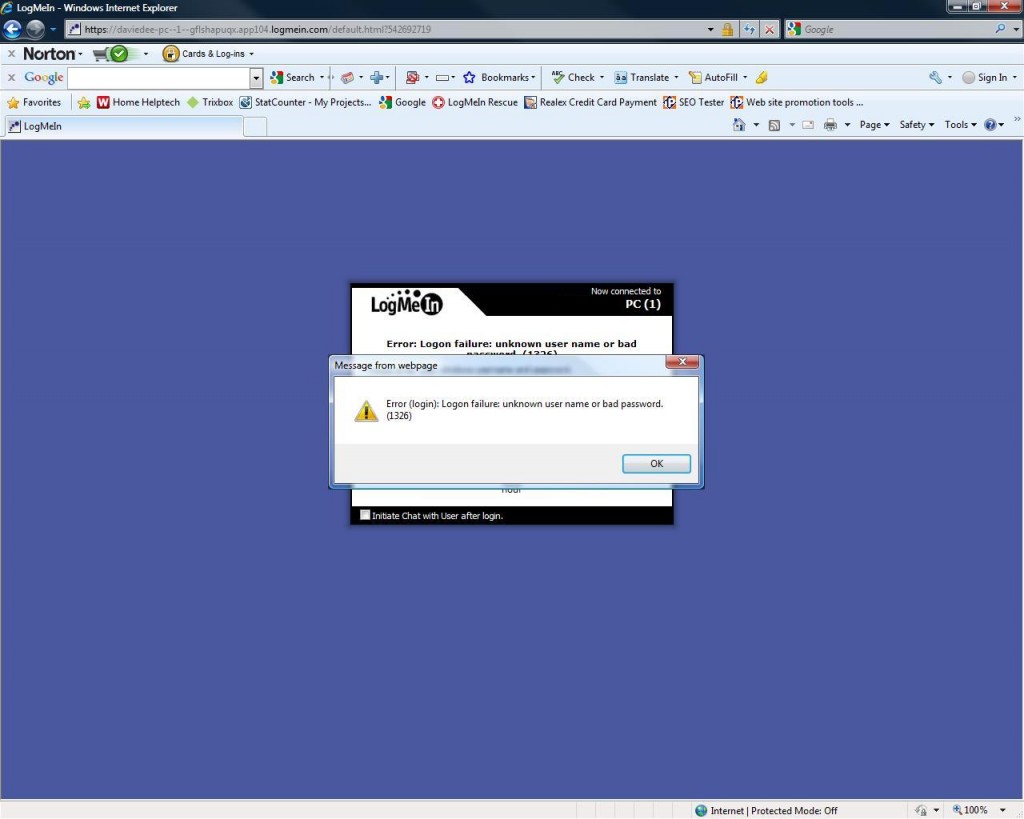
It eventually locked me out.
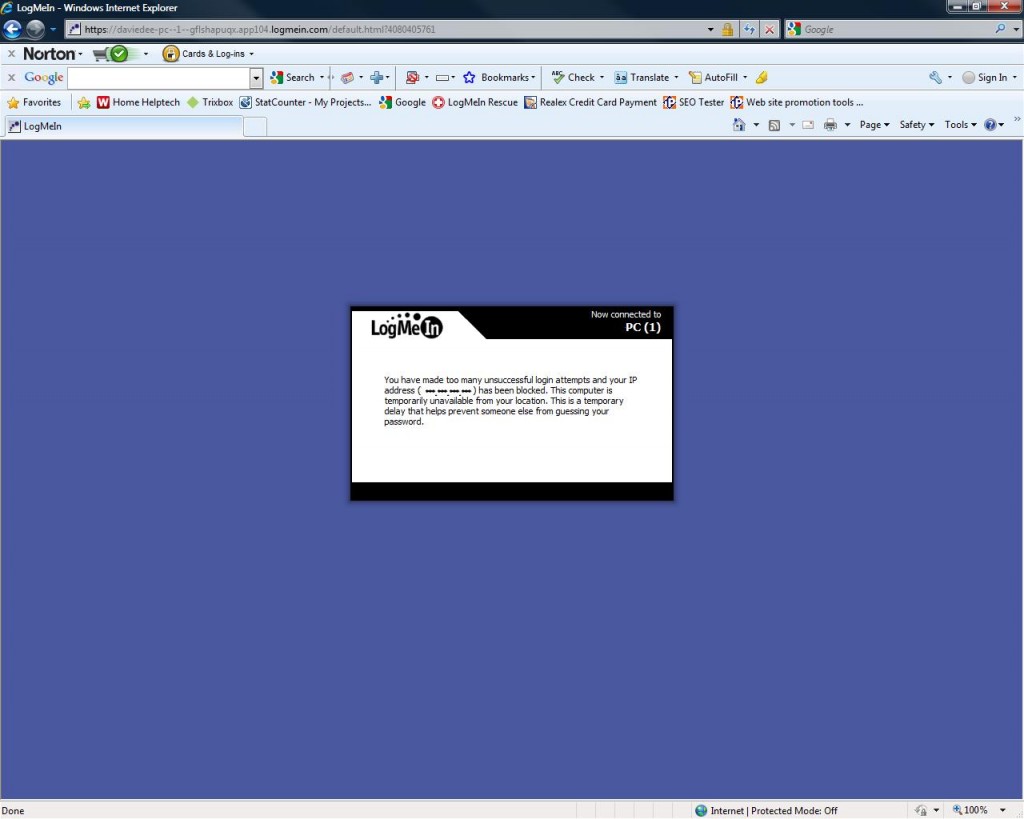
after a while I finally discovered what the issue was:
Usually with Windows XP and Windows Vista you only need your Login name and Password for that machine to gain remote control of that machine. But with Windows 7 you need to enter your “computername”/”user name” as your username for it to work for example look at the screenshot below
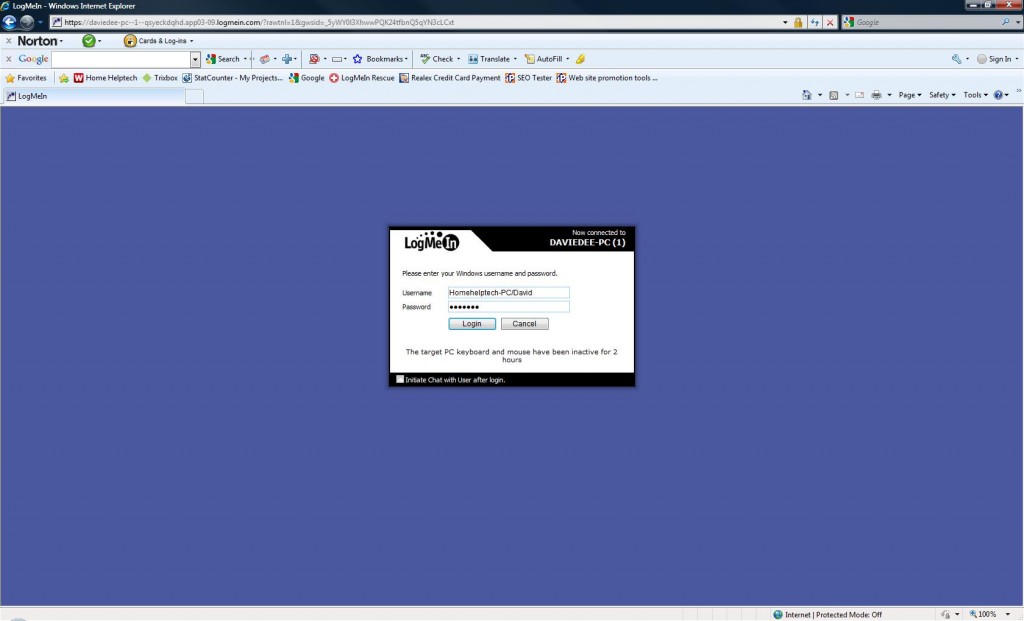
Username : Homehelptech-PC/David
Password: Letmein (dont even try… its not my real password)
after this you should be able to access your Windows 7 machine. Good Luck!!
If you have any problems with these steps or any other problems please don’t hesitate to call one of our qualified engineers and technicians and we will be delighted to perform the required steps to deal with your problem.
| Lo-Call 1890 219 219 (Ireland) | Freefone 0808-CALHELP (UK) |
| Business Hours: Monday – Friday 9:45 to 6:30 & Saturday 9:00 to 12:00 |
- Bookmark :
- Digg
- del.icio.us
- Stumbleupon
- Redit it
Aug
What Our Customers Say
Posted by (41) Comment
 Dear Customer, We care about what you thought of the service you got from Home Helptech. So if you have used our service, we invite you to post your feedback here so that both we and our customers can benefit from knowing about your experience of using our service. Please write your comments accompanied by your name and location. We will not share your email address but require it and the “CAPCTHA” code for validation. Simon Martin Managing Director, Home Helptech Ltd Note: 9/2/2013 – Apologies to our customers – we have temporarily suspended feedback due to a high volume of spam.
Dear Customer, We care about what you thought of the service you got from Home Helptech. So if you have used our service, we invite you to post your feedback here so that both we and our customers can benefit from knowing about your experience of using our service. Please write your comments accompanied by your name and location. We will not share your email address but require it and the “CAPCTHA” code for validation. Simon Martin Managing Director, Home Helptech Ltd Note: 9/2/2013 – Apologies to our customers – we have temporarily suspended feedback due to a high volume of spam.
- Bookmark :
- Digg
- del.icio.us
- Stumbleupon
- Redit it
Aug
A windows update pushed out this week for Windows Vista is causing the blue screen of death on certain machines. The update, KB973879, is aimed at resolving another issue caused by installing Vista Service Pack 2. The blue screen caused by this update is pictured below – picture provided by a customer who had the presence of mind when it occured. It causes a STOP: 0x0000007E or a STOP: 0x00000050
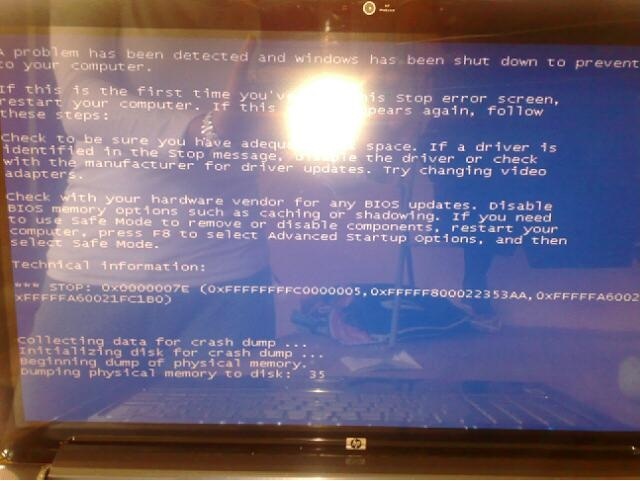
See: https://support.microsoft.com/kb/973879/us
To rectify the problem, go into safe mode and remove this patch from Add or Remove Programs applet in the Control Panel. View updates by clicking on “View Installed Updates”. Select update KB973879 and click Uninstall.
If you have any problems with these steps or any other problems please don’t hesitate to call one of our qualified engineers and technicians and we will be delighted to perform the required steps to deal with your problem.
| Lo-Call 1890 219 219 (Ireland) | Freefone 0808-CALHELP (UK) |
| Business Hours: Monday – Friday 9:45 to 6:30 & Saturday 9:00 to 12:00 |
- Bookmark :
- Digg
- del.icio.us
- Stumbleupon
- Redit it
Aug
Netgear firmware breaks Voice over IP (VOIP) SIP connections
Posted by Comments Off on Netgear firmware breaks Voice over IP (VOIP) SIP connections
For those customers in Ireland who use the Netgear DG834G v4, the most recent firmware version v5.01.14 claims to resolve a DSL problem specifically related to Irish connections. We recently upgraded a router to this version of firmware and it completely disrupted SIP based VOIP calls over the network concerned. The symptom is that you are unable to hear the person at the other end of the phone, even though they can hear you. There are also reports that it breaks skype. So if you use Skype or SIP based telephony, be wary of upgrading to this version of firmware.
Downgrading back to version 5.01.09 resolved our telephony problems.
If you have any problems with these steps or any other problems please don’t hesitate to call one of our qualified engineers and technicians and we will be delighted to perform the required steps to deal with your problem.
| Lo-Call 1890 219 219 (Ireland) | Freefone 0808-CALHELP (UK) |
| Business Hours: Monday – Friday 9:45 to 6:30 & Saturday 9:00 to 12:00 |
- Bookmark :
- Digg
- del.icio.us
- Stumbleupon
- Redit it
Aug
Encrypting Your Hard Disk Using Bitlocker
Posted by Comments Off on Encrypting Your Hard Disk Using Bitlocker
With the many publicised cases of laptop and data theft that have been in the news lately, many people are beginning to think seriously about how to protect the data they have on their laptops. You may simply have private documents, pictures and passwords stored on your laptop or you may carry important, confidential information that really needs to be protected. One of the ways of doing this is to use the bitlocker full-drive encryption system which is included in some of the upmarket versions of windows.
Bitlocker is a feature that comes with the Enterprise and Ultimate editions of Windows Vista and Windows 7. If you have one of the other editions of windows, you can upgrade by buying a “Windows Anytime” upgrade for Ireland or the UK. Bitlocker can be configured in quite a few ways but the easiest and most common is where the laptop concerned contains a TPM (Trusted Platform Module) which is a chip that supports encryption. That is what I will demonstrate in this blog.
Finding out if you have a Trusted Platform Module (TPM)
The first thing you need to do is establish if you have a TPM module. You can do this by checking in your device manager.
Log onto your machine using an account that has Local Administrator priveledges. If your computer is a business machine which is part of a domain, you may need to ask your domain administrator for access.
Click on the start button, right click on “Computer” and then click on “Manage” to open the Computer Management window.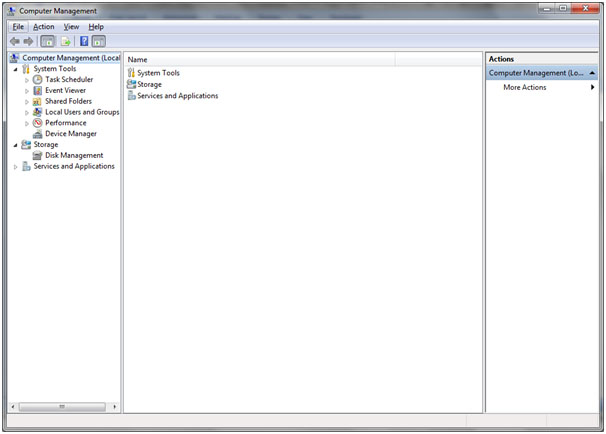
Click on Device Manager to access the device manager. Then click on “Security Devices” in the right pane to reveal your TPM. If it’s not there then you either don’t have one, or it is turned off in BIOS and you need to turn it on.
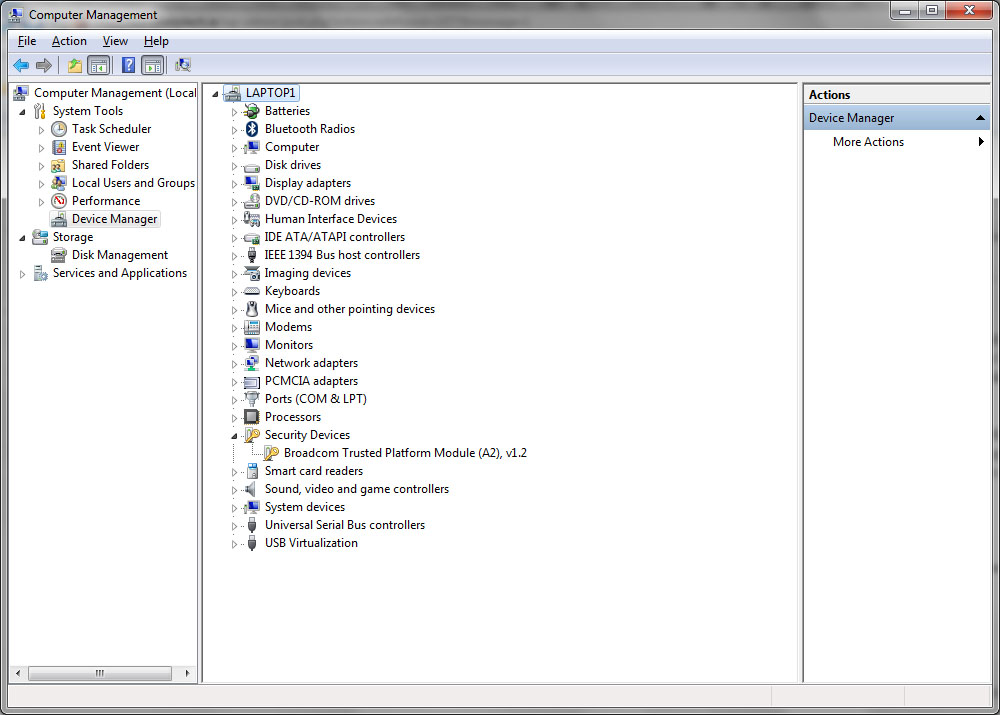
While you’re there, right click on the TPM device and click on the driver tab to ensure you have the correct driver. The name of this has changed in Windows 7 (at least on my machine). The important thing is that you’re running v1.2 of the TPM driver.
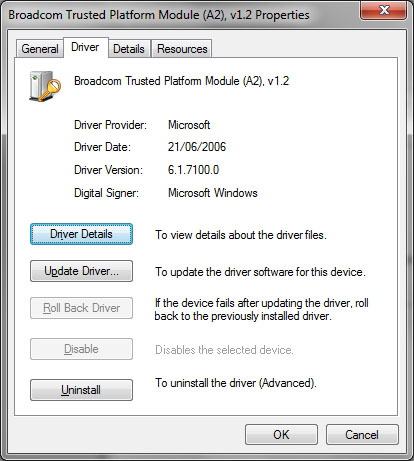
Preparing your TPM
The first thing you need to do is to prepare your TPM. Click on your Start button and type tpm.msc as shown below.
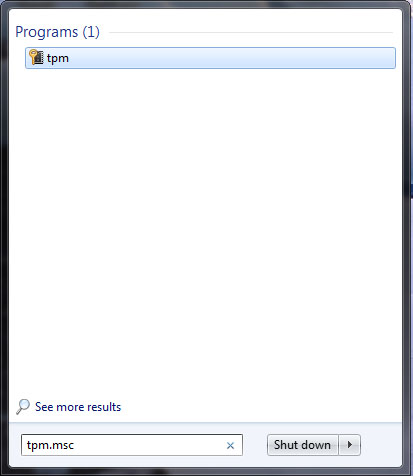
This will open the TPM management console as shown below.
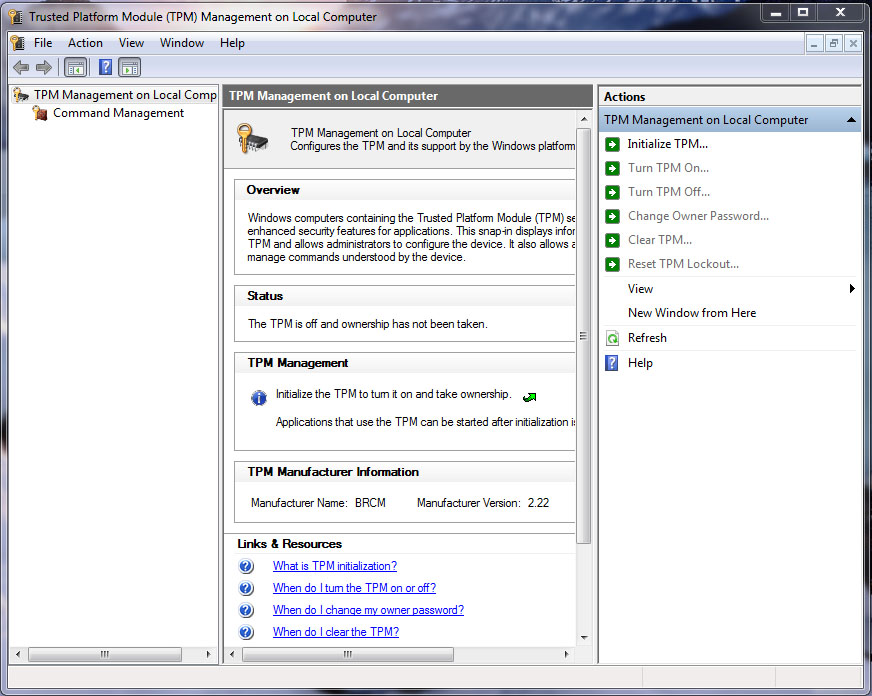
Click on “Initialise TPM” to start the process.
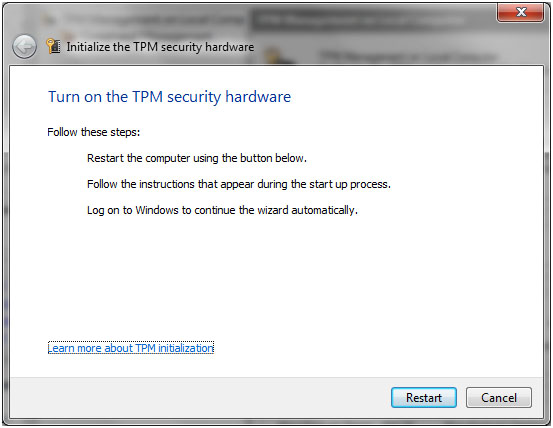
Click restart to restart your machine.
When the machine reboots, a BIOS screen will ask you to confirm the modification. Once you’ve agreed, windows will restart and ask you to create a password.
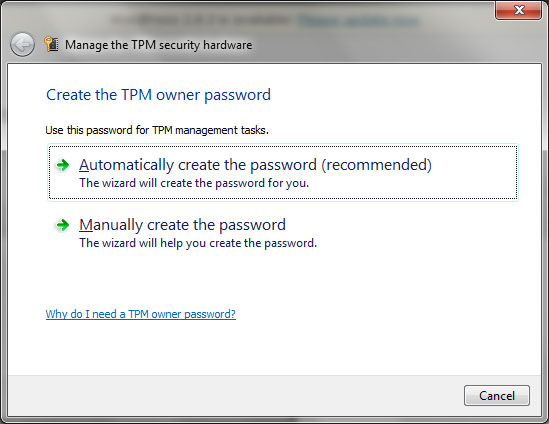
Click “Automatically create the password (recommended)”. You’ll then see your password in the next window. I’ve blurred out the one I generated
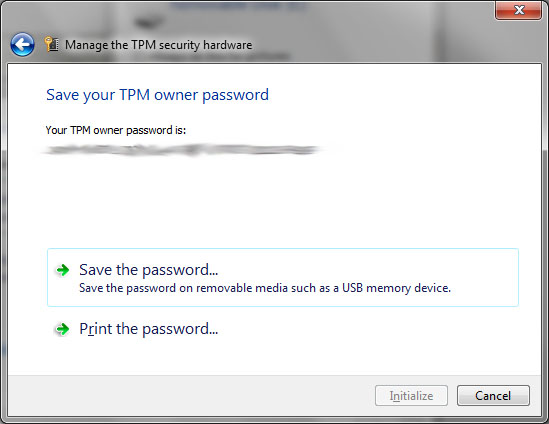
Save the file to a USB key as shown below.
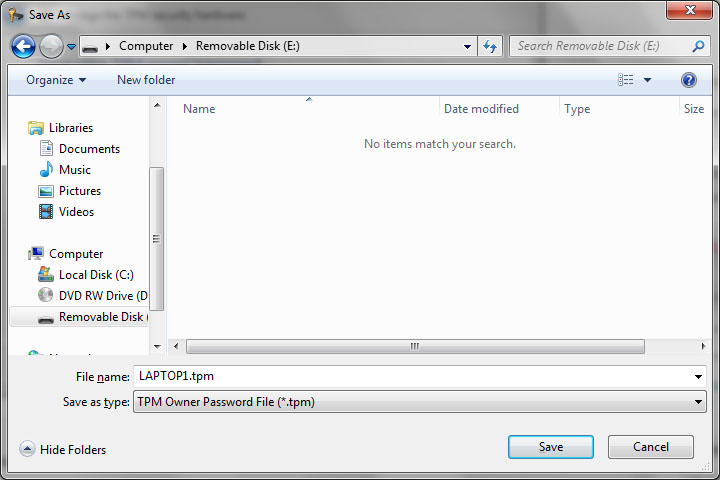
Label the USB key carefully and put it in a safe place. You will need it if anything goes wrong with bitlocker in the future.
Back on the Save TPM Owner windows above, click “Initialize”
The TPM will be initialised.
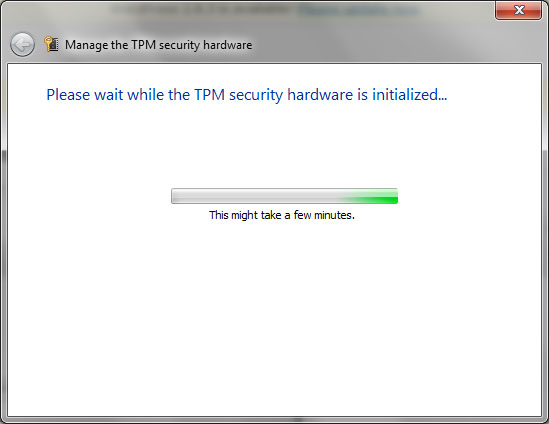
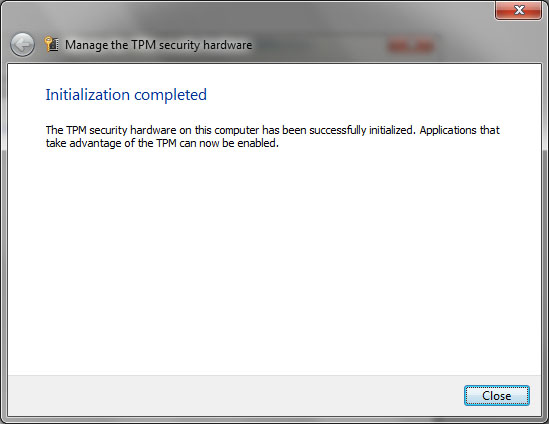
Click Close
Your TPM should now be intialised and set up. You can check this by going back into the TPM management console, it should look like this now.
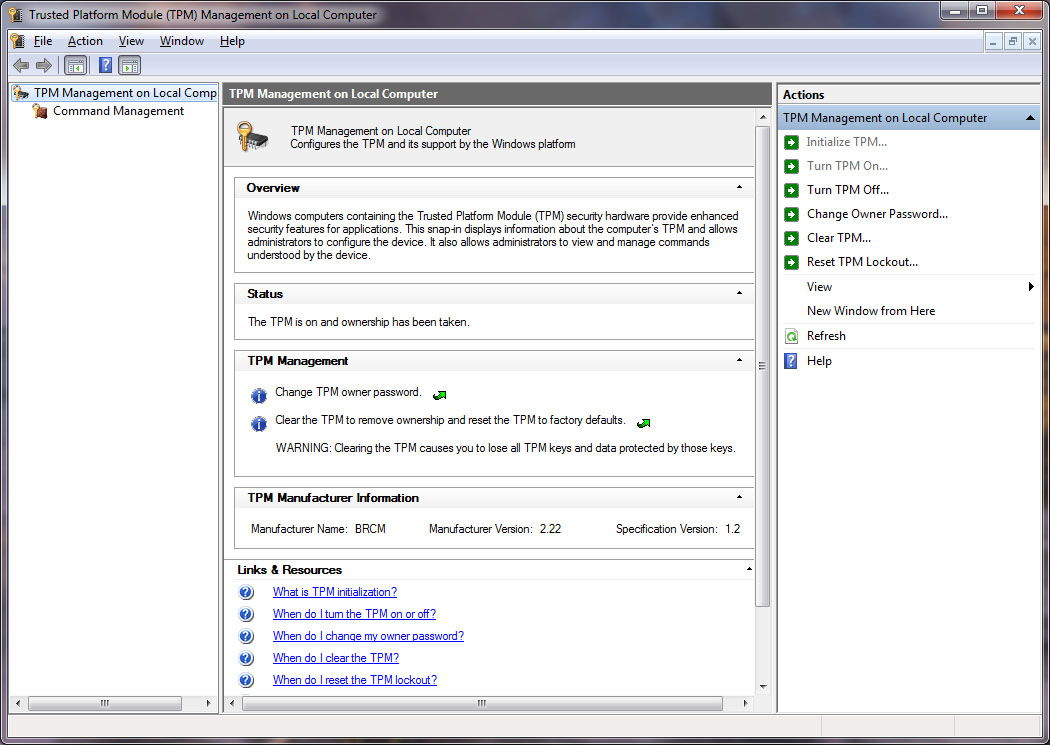
Hard Disk Preparation for Bitlocker
Bitlocker also requires a small partition at the start of your disk where the unencrypted boot volume resides. I created this partition manually. However, there is now a tool to do it automatically which you can download at the following link: BitLocker Drive Preparation Tool. After the drive is prepared, there should be a partitioning scheme similar to the one below. You can check this by clicking the Start button and typing diskmgmt.msc.
N.B. This snapshot was taken after encryption, so initially your partitions will will not show as “BitLocker Encrypted” as shown below – that comes later.
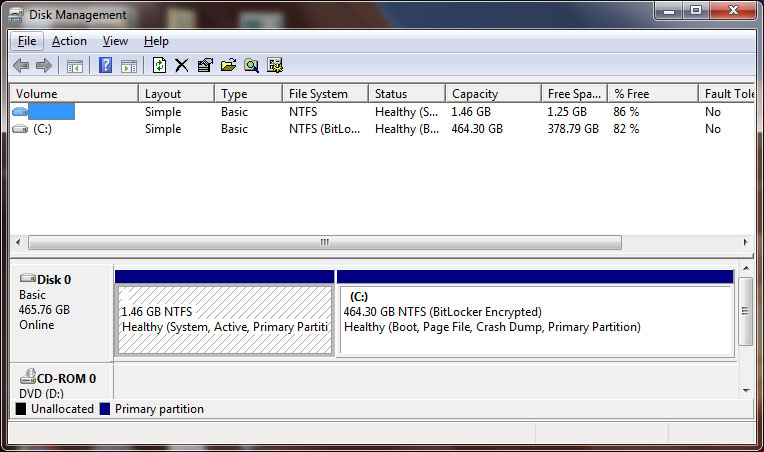
Setting up Bitlocker
Now it’s time to start Bitlocker. You can find it in the Control Panel under System and Security.
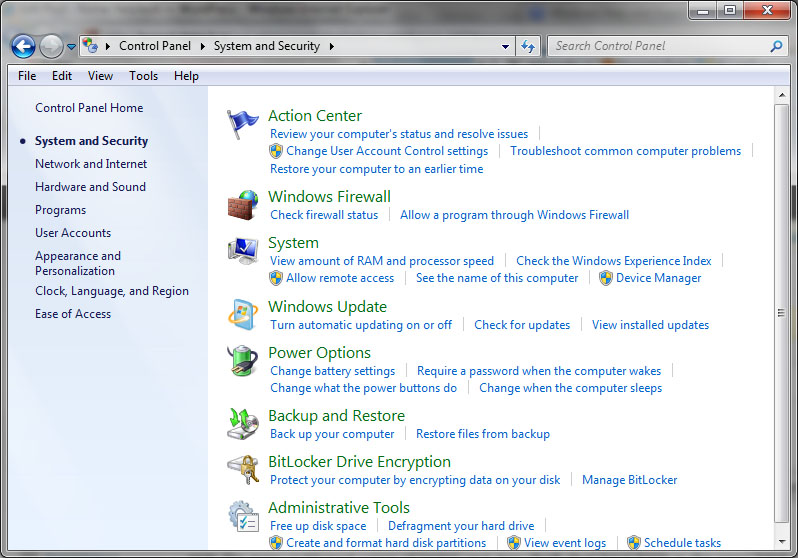
Click on Bitlocker Drive Encryption
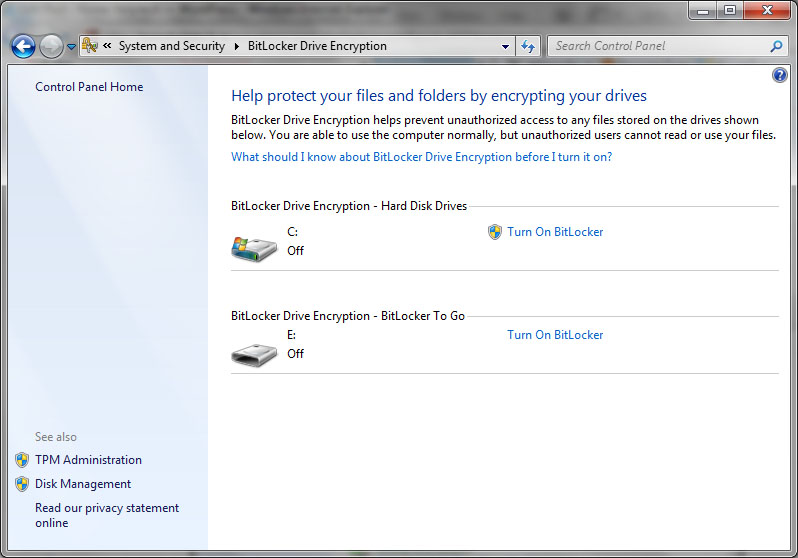
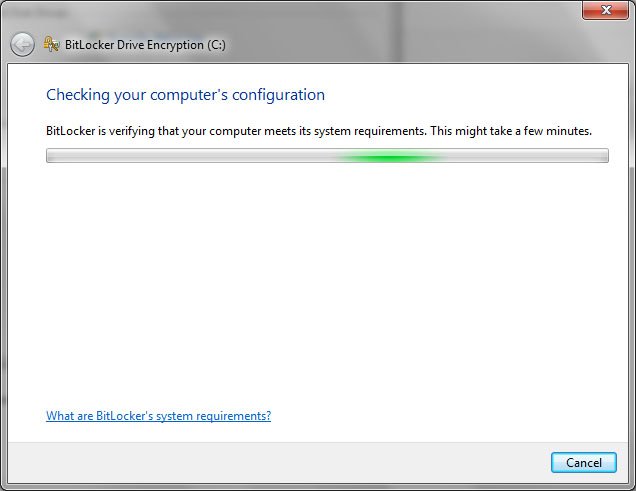
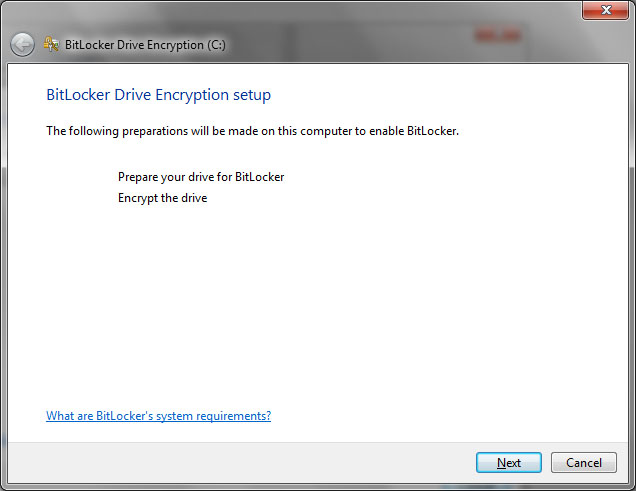
Click Next
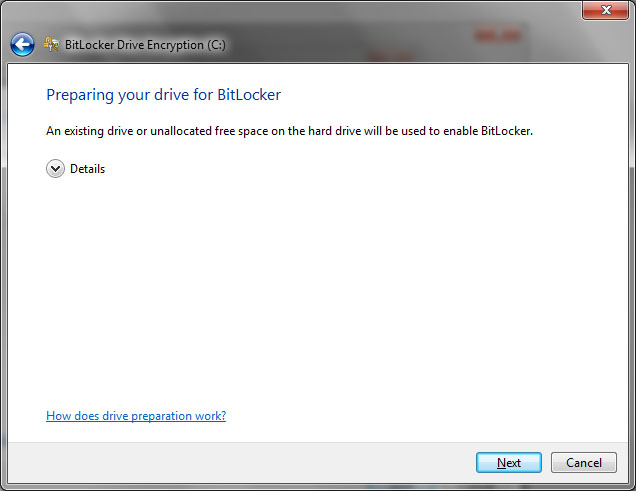
Click Next
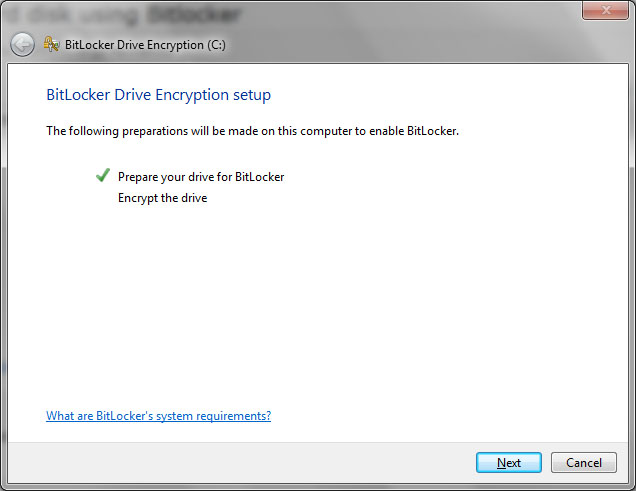
Click Next
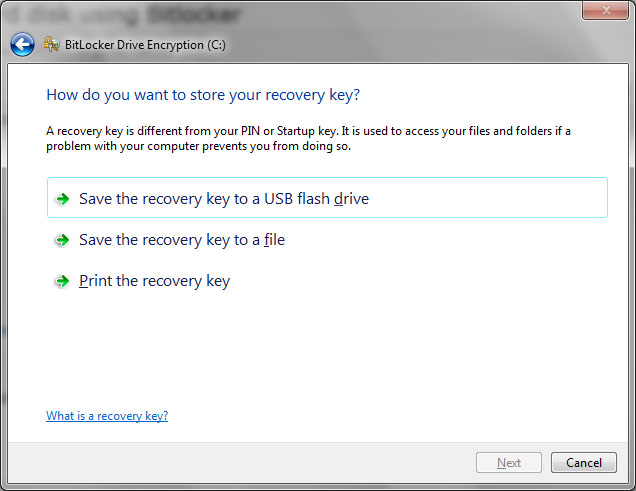
Using the same USB key as before,click on Save the Recovery key to a USB flash drive
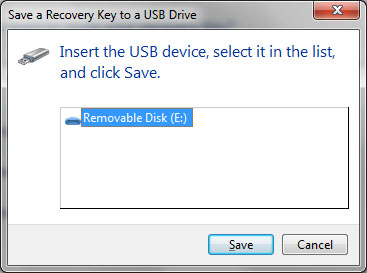
Click save and then next on the previous window.
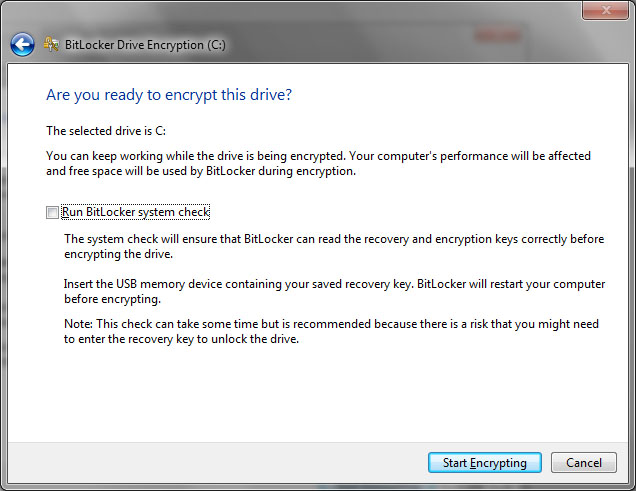
Click Run Bitlocker system check and then click Continue, which appears instead of Start Encrypting.
Click Restart Now when it appears.
The machine will reboot, will briefly show a Bitlocker message when it is restarting and will then re-enter windows. Log in as normal.
It will then start encrypting your disk.
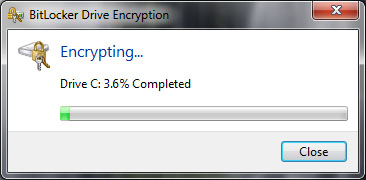
You then need to wait for the encryption to complete. In my case a relatively high spec laptop took around 6 hours to encrypt around 130GB of data. When the encryption completes, the following message is displayed.
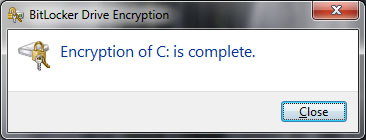
That’s it. You’re done and your data is safe from prying eyes in the future.
If you have any problems with these steps or any other problems please don’t hesitate to call one of our qualified engineers and technicians and we will be delighted to perform the required steps to deal with your problem.
| Lo-Call 1890 219 219 (Ireland) | Freefone 0808-CALHELP (UK) |
| Business Hours: Monday – Friday 9:45 to 6:30 & Saturday 9:00 to 12:00 |
- Bookmark :
- Digg
- del.icio.us
- Stumbleupon
- Redit it
Aug
Business Accounting Packages
Sage is, of course, king of the small business accounting packages in Ireland but with the recession now in full swing, people have been asking about lower cost or free alternatives. With this in mind, it’s worth noting that there are finally some free small business accounting packages available on the Irish market.
TAS books now offers a basic accounting package, aptly named TAS Books Basic does the basics for a small business at no cost.
I can’t help suspecting that in offering a free basic package, TAS is “getting their retaliation in first” against the rumoured release of an international english edition of Microsoft Office Accounting Express which already free in the UK. This package is tightly integrated with the other Microsoft solutions, including Microsoft Office. There is also an easy upgrade path to the inexpensive Professional edition which scales to multi-person and server installations. In fact, the UK version is already quite usable in an Irish context and if you google around enough, it’s even possible to find an unsupported Euro configuration file for those who really want to use it.
Update 1st November 2009: Microsoft are exiting the UK accounting market and will not support Microsoft Office Accounting Express long term
Free Payroll Software
Also getting in on the free software act is Sage themselves, who now offer their Quickpay Free payroll software free for businesses with 1-3 users. Phone registration is required after which you can get free upgrades any time the PAYE/PRSI rules change. The downside of this product is that you will need to buy custom payroll stationery which can erode the value of the “free” offer.
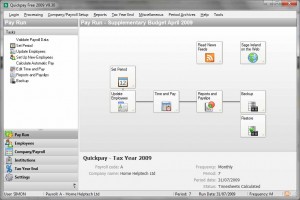
Free payroll software
If you’d rather avoid the need to buy custom blank payslips, we’d recommend that you consider Thesaurus as a payroll package. Thesaurus is an Irish company and is generally considered easier to use than Sage Quickpay. Unfortunately there is no free version of Thesaurus, though there is a free trial available if you wish to try before you buy. The standard version costs €140 per annum. We are agents for Thesaurus, so if you wish to source a copy, do give us a call and we can help you.
Links
Links for each of these packages can be found below.
Microsoft Office Accounting Express (link removed due to product discontinuance)
If you have any problems with these steps or any other problems please don’t hesitate to call one of our qualified technicians and we will be delighted to perform the required steps to deal with your problem.
| Lo-Call 1890 219 219 |Business Hours: Monday – Friday 9:00 to 17:30
- Bookmark :
- Digg
- del.icio.us
- Stumbleupon
- Redit it
Aug
How to remove Windows XP Service Pack 3
Posted by Comments Off on How to remove Windows XP Service Pack 3
Sometimes when windows xp service pack 3 is installed some devices may not work as well as they did before the installation. here is a guide to removing Service pack 3 and rolling back to Service Pack 2.
there are 3 types of ways you can remove the Service Pack :
Use the Add or Remove Programs application in the control panel
- Click on the Start button in the bottom left-hand corner of your screen
- Now click on Control Panel on the right had side of the menu
- Select Add or Remove Programs and a new window will appear
- Tick the Show Updates box and scroll down to Windows XP Service Pack 3
- Highlight it and click Remove
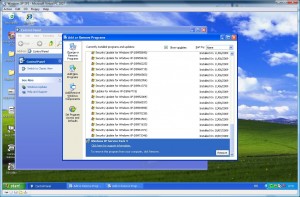
Use a removal wizard that is stored in a hidden folder
- Click on the Start button in the bottom left hand corner of your screen
- Click on My Computer and a new window will appear
- Select Tools and click on Folder Options from the drop-down menu
- Click on the View tab at the top of the new window
- Scroll down to Show Hidden Files and Folders and make sure the radio button is ticked.
- Click Apply and OK
- Now open your Hard Disk Drive where Windows is installed usually (C:)
- now open the next folders Windows > $NtServicePackUninstall$ > Spuninst
- Click on Spuninst applacation
- follow Uninstallation Wizard steps and let it restart your computer if needs be.
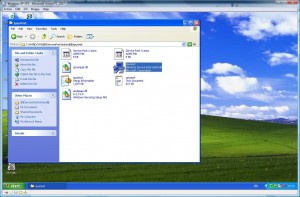
Restore to an earlier point
- follow our post on how to do a system restore below. make sure you select a date just before you installed Windows XP Service Pack 3.
If you have any problems with these steps or any other problems please don’t hesitate to call one of our qualified technicians and we will be delighted to perform the required steps to deal with your problem.
| Lo-Call 1890 219 219 |Business Hours: Monday – Friday 9:45 to 6:30 & Saturday 9:00 to 12:00 |
- Bookmark :
- Digg
- del.icio.us
- Stumbleupon
- Redit it




